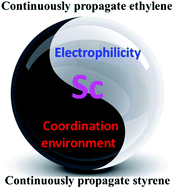Sequence-controlled ethylene/styrene copolymerization catalyzed by scandium complexes†
Abstract
Rare earth metal-based complexes can catalyze ethylene/styrene copolymerization to give copolymers with long syndiotactic polystyrene sequences. Here, sequence-controlled ethylene/styrene copolymerization was achieved by regulating the electronic and steric properties of scandium precursors. When a thiophene-fused cyclopentadienyl scandium complex 1, (2,4,5,6-Me4-4H-cyclopenta[b]thiophenyl)Sc(CH2SiMe3)2, was used, a copolymer with long syndiotactic polystyrene sequences was obtained. The tetrahydrofuran (THF) adduct of complex 1 (1·THF) showed lower activity to give a copolymer with short polystyrene sequences owing to an increase in the steric effects around the metal center. The pyridine adducts 1·Py and 1·PyF5 were totally inert. Under the same conditions, complex 2 ((2,5-dimethyl-3-phenyl-4-H-cyclopenta[b]thiophenyl)Sc(CH2SiMe3)2), an analog of 1, incorporated styrene discretely into the copolymer to form a “pseudo random” microstructure. Complex 3 bearing a bulky and less electron-donating constrained-geometry configuration ligand ((Flu-CH2–Py)Sc(CH2SiMe3)2) could catalyze copolymerization in a livingness manner to afford copolymers containing mainly the alternating ethylene/styrene sequence, where a fast and reversible chain-transfer reaction to aluminum alkyl was observed. The influences of structural and electronic factors of the scandium precursors, such as the steric bulkiness of a ligand and incorporation of a Lewis base to the active metal center, on the catalytic activity and sequence distribution of the resulting copolymers were elucidated.



 Please wait while we load your content...
Please wait while we load your content...